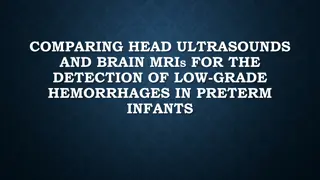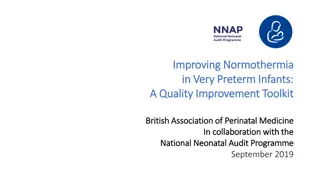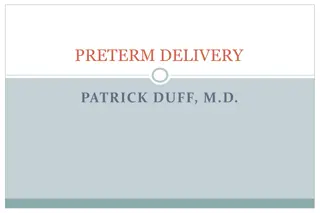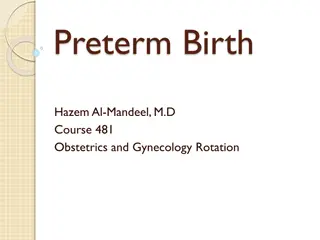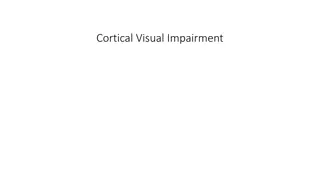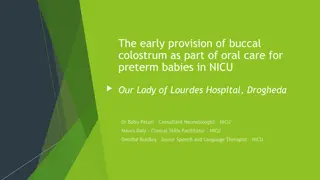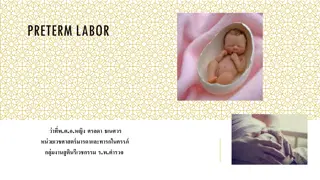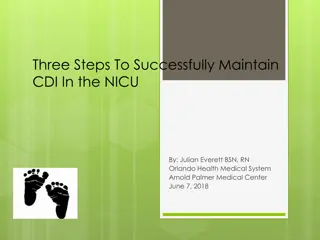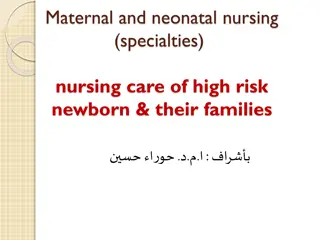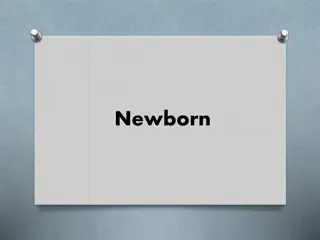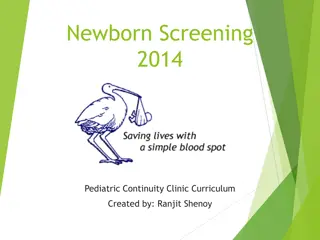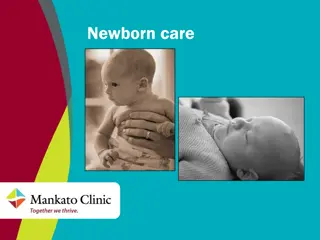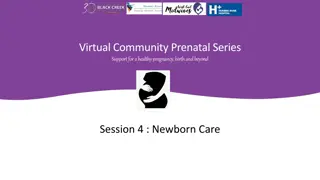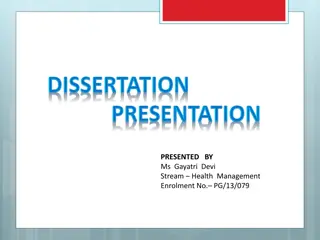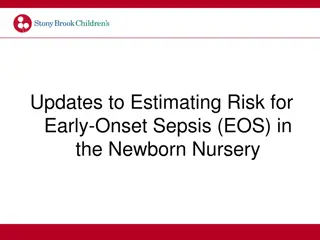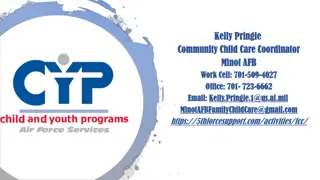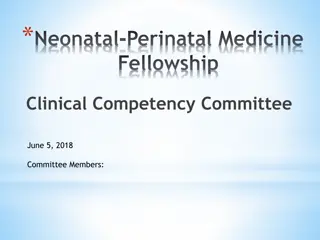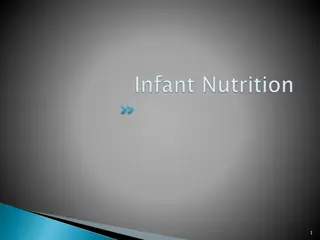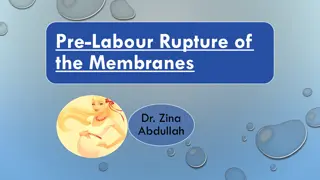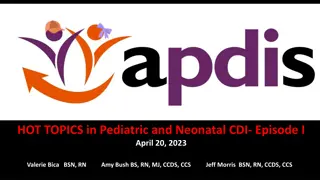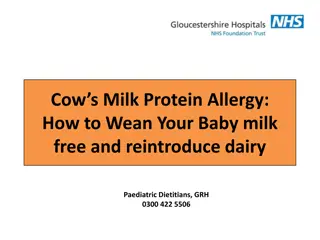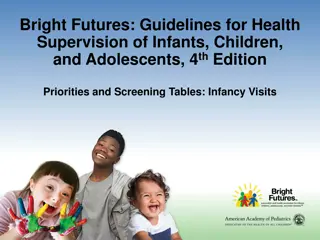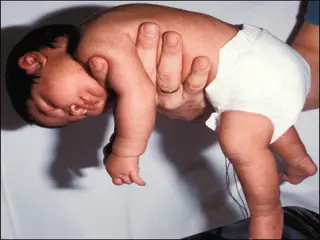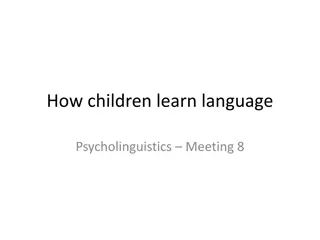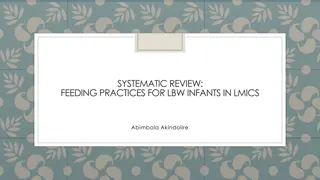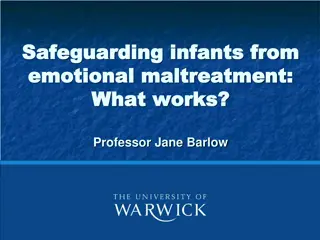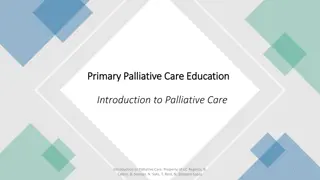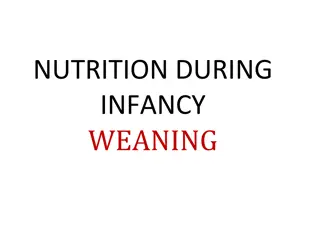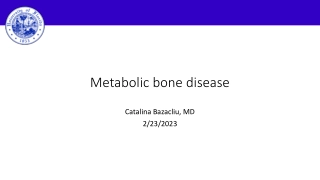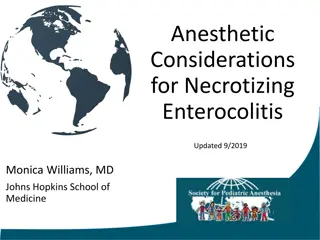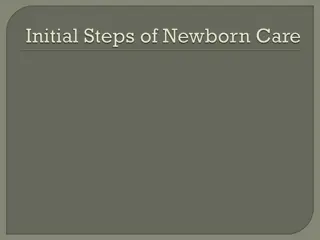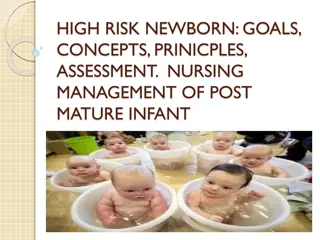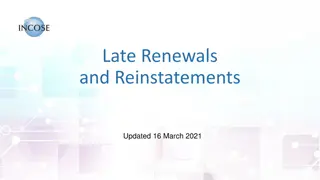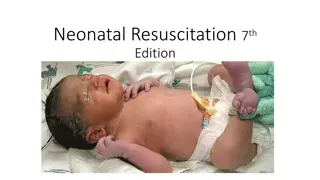Newborn Care Curriculum for Late Preterm Infants in Level II NICU
This curriculum module focuses on the care of late preterm infants in Level II NICU settings, covering topics such as respiratory management, feeding difficulties, hypoglycemia, hypothermia, sepsis, hyperbilirubinemia, and discharge planning. It includes learning objectives, nursery care levels, physiological differences between term and late-preterm infants, management plans for common issues, and evaluation of discharge readiness. The content emphasizes understanding nursery care levels, formulating appropriate management strategies, and organizing safe discharge plans for late preterm infants.
Download Presentation

Please find below an Image/Link to download the presentation.
The content on the website is provided AS IS for your information and personal use only. It may not be sold, licensed, or shared on other websites without obtaining consent from the author. Download presentation by click this link. If you encounter any issues during the download, it is possible that the publisher has removed the file from their server.
E N D
Presentation Transcript
Newborn Care Curriculum: The Late Preterm Infant in the Level II NICU Elena Aragona, MD Rebekah Conroy, MD
Newborn Care Curriculum The Late Preterm Infant in the Level II NICU Learning objectives Learning objectives Nursery care levels Nursery care levels Introduction Introduction Physiology and Management Welcome to the Newborn Care Curriculum: Late Preterm in the Level II NICU learning module Please take a few minutes to complete the pretest associated with this module. Physiology and Management Respiratory Respiratory Feeding Difficulties Feeding Difficulties Hypoglycemia Hypoglycemia Hypothermia Hypothermia Sepsis Sepsis Hyperbilirubinemia Hyperbilirubinemia Discharge planning Discharge planning Summary Summary References References
Newborn Care Curriculum The Late Preterm Infant in the Level II NICU Learning objectives Learning objectives Learning Objectives Nursery care levels Nursery care levels Describe nursery care levels and understand which infants are appropriate for care at each level Review physiologic differences between term and late-preterm infants Formulate management plans for common problems seen in late preterm infants Evaluate late preterm infants appropriate for discharge and organize safe discharge plans Introduction Introduction Physiology and Management Physiology and Management Respiratory Respiratory Feeding Difficulties Feeding Difficulties Hypoglycemia Hypoglycemia Hypothermia Hypothermia Sepsis Sepsis Hyperbilirubinemia Hyperbilirubinemia Discharge planning Discharge planning Summary Summary References References
Newborn Care Curriculum The Late Preterm Infant in the Level II NICU Learning objectives Learning objectives Nursery Care Levels Nursery care levels Nursery care levels 1976 March of Dimes report Toward Improving the Outcome of Pregnancy 3 levels of complexity for maternal and neonatal care Referral to higher-level center for higher risk Higher-level centers provide appropriate care through the availability of increased resources Introduction Introduction Physiology and Management Physiology and Management Respiratory Respiratory Feeding Difficulties Feeding Difficulties Hypoglycemia Hypoglycemia Hypothermia Hypothermia Sepsis Sepsis Hyperbilirubinemia Hyperbilirubinemia Discharge planning Discharge planning Summary Summary American Academy of Pediatrics Committee on Fetus And Newborn, 2012 References References
Newborn Care Curriculum The Late Preterm Infant in the Level II NICU Learning objectives Learning objectives Nursery Care Levels Nursery care levels Nursery care levels Introduction Basic well baby nursery Introduction Level 1 Physiology and Management Physiology and Management Respiratory Specialty care for stable or moderately ill infants >= 32 wks Treatment for problems expected to resolve rapidly Check with your state Department of Health as some use different criteria to define NICU levels. Respiratory Level 2 Feeding Difficulties Feeding Difficulties Hypoglycemia Hypoglycemia Hypothermia Subspecialty care for critically ill newborns Hypothermia Level 3 Sepsis Sepsis Hyperbilirubinemia Hyperbilirubinemia Level 3 care plus availability of pediatric surgical subspecialties Discharge planning Level 4 Discharge planning Summary Summary American Academy of Pediatrics Committee on Fetus And Newborn, 2012 American Academy of Pediatrics ; American College of Obstetricians and Gynecologists, 2012 References References
Newborn Care Curriculum The Late Preterm Infant in the Level II NICU Learning objectives Introduction to Late Preterm Infants (LPI) Learning objectives Nursery care levels Nursery care levels Infants born between 34 and 37 weeks gestation 2005 NIH workshop recommended the term Late Preterm Emphasizes these infants ARE preterm At risk for higher morbidity and mortality secondary to immaturity related medical complications Introduction Introduction Physiology and Management Physiology and Management Respiratory Respiratory Feeding Difficulties Feeding Difficulties Hypoglycemia Hypoglycemia Hypothermia Hypothermia Sepsis Sepsis Hyperbilirubinemia Hyperbilirubinemia Discharge planning Discharge planning Summary Summary References Martin et al, 2015; Engle W. A., 2006; Engle W. A. et al, 2007 References
Newborn Care Curriculum The Late Preterm Infant in the Level II NICU Learning objectives Learning objectives LPI: Scope of the Problem Nursery care levels Nursery care levels 1 in 10 births Some textbooks now have chapters dedicated to the LPI LPI make up 70-80% of preterm births LPI account for 25-33% of NICU admissions Introduction Introduction Physiology and Management Physiology and Management Respiratory Respiratory Feeding Difficulties Feeding Difficulties Hypoglycemia Hypoglycemia Hypothermia Hypothermia Sepsis Sepsis Hyperbilirubinemia Hyperbilirubinemia Discharge planning Discharge planning Graph adapted from: March of Dimes, 2011. Summary Summary References Gleason, Devaskar & Avery, 2012 References
Newborn Care Curriculum The Late Preterm Infant in the Level II NICU Learning objectives Complications of the LPI Learning objectives Nursery care levels Nursery care levels Although preterm infants may look similar to term infants, they are physiologically immature without appropriate compensatory mechanism for extra-uterine life Decreased surfactant, decreased lung volume, and decreased ability to clear lung fluid after birth Ineffective thermoregulation Inadequate suck/swallow coordination, immature GI function Lack of optimal ketogenic response, limited glycogen reserves Brainstem development is less mature Introduction Introduction Physiology and Management Physiology and Management Respiratory Respiratory Feeding Difficulties Feeding Difficulties Hypoglycemia Hypoglycemia Hypothermia Hypothermia Sepsis Sepsis Hyperbilirubinemia Hyperbilirubinemia Discharge planning Discharge planning Summary Summary Darnall, R. A. et al, 2006; Engle, W. A., 2009; Garg, M., & Devaskar, S. U, 2006; Shapiro-Mendoza, C. K., & Lackritz, E. M. , 2012; Tomashek, K. M. et al., 2006; Wang, M. L. et al, 2004 References References
Newborn Care Curriculum The Late Preterm Infant in the Level II NICU Learning objectives Complications of the LPI Learning objectives Nursery care levels Nursery care levels Introduction Introduction Physiology and Management Physiology and Management Respiratory Respiratory Increased mortality and risk of readmission. Feeding Difficulties Feeding Difficulties Graph adapted from: Wang ML et al, 2004 Hypoglycemia Hypoglycemia Hypothermia Hypothermia Sepsis Sepsis Hyperbilirubinemia Hyperbilirubinemia Discharge planning Discharge planning Summary Summary Darnall, R. A. et al., 2006; Engle, W. A., 2009; Garg, M., & Devaskar, S. U., 2006; Shapiro- Mendoza, C. K., & Lackritz, E. M., 2012; Tomashek, K. M. et al, 2006; Wang M.L, 2004 References References
Newborn Care Curriculum The Late Preterm Infant in the Level II NICU Learning objectives Physiology and Management Learning objectives Nursery care levels Nursery care levels Introduction Introduction Physiology and Management Physiology and Management Respiratory Complications Feeding Difficulties Hypoglycemia Respiratory Respiratory Feeding Difficulties Feeding Difficulties Hypoglycemia Hypoglycemia Hypothermia Hypothermia Sepsis Temperature Instability Sepsis Infection Risk Hyperbilirubinemia Hyperbilirubinemia Hyperbilirubinemia Discharge planning Discharge planning Summary Summary Darnall, R. A. et al, 2006; Engle, W. A., 2009; Garg, M., & Devaskar, S. U, 2006; Shapiro-Mendoza, C. K., & Lackritz, E. M. , 2012; Tomashek, K. M. et al., 2006; Wang, M. L. et al, 2004 References References
Newborn Care Curriculum The Late Preterm Infant in the Level II NICU Learning objectives Respiratory Problems: Physiology review Learning objectives Nursery care levels Nursery care levels Surfactant Introduction Introduction Physiology and Management Physiology and Management Lung volume Respiratory Respiratory Feeding Difficulties Feeding Difficulties Hypoglycemia Ability to clear fluid Hypoglycemia Hypothermia Hypothermia Sepsis Sepsis Immature breathing control Hyperbilirubinemia Hyperbilirubinemia Discharge planning Discharge planning Airway tone Summary Summary References References
Newborn Care Curriculum The Late Preterm Infant in the Level II NICU Learning objectives Respiratory Problems: Manifestations Learning objectives Nursery care levels Nursery care levels Introduction Introduction Respiratory Distress Syndrome (RDS) Physiology and Management Physiology and Management Transient Tachypnea of the Newborn (TTN) Respiratory Respiratory Feeding Difficulties Feeding Difficulties Apnea of Prematurity Hypoglycemia Hypoglycemia Persistent pulmonary hypertension (PPHN) Hypothermia Hypothermia Sepsis Sepsis Pneumonia Hyperbilirubinemia Hyperbilirubinemia Discharge planning Discharge planning Others Summary Summary References References Stokowski, 2005; Zhao, 2011
Newborn Care Curriculum The Late Preterm Infant in the Level II NICU Learning objectives Respiratory Problems: Presentation and evaluation Learning objectives Nursery care levels Nursery care levels Physical Exam Introduction Introduction Physiology and Management Tachypnea (normal: 30-60) Increased work of breathing (grunting, flaring, and retracting) Oxygen requirement Evaluation 29% of LPI vs. 4% Term have sustained respiratory distress > 2hrs after birth (Wang et al., 2004) Physiology and Management Respiratory Respiratory Feeding Difficulties Feeding Difficulties Hypoglycemia Hypoglycemia CBC with differential Blood culture Blood gas Pre/post ductal pulse ox readings Chest X-Ray Hypothermia Hypothermia Sepsis Sepsis Hyperbilirubinemia Hyperbilirubinemia Discharge planning Discharge planning Summary Summary References References Wang, M. L., 2004
Newborn Care Curriculum The Late Preterm Infant in the Level II NICU Learning objectives Respiratory Problems: Management Learning objectives Nursery care levels Nursery care levels Introduction Introduction Oxygen Physiology and Management Physiology and Management Respiratory Respiratory Feeding Difficulties Feeding Difficulties Hypoglycemia Hypoglycemia CPAP Hypothermia Hypothermia Sepsis Sepsis Hyperbilirubinemia Hyperbilirubinemia Discharge planning Discharge planning Intubation Summary Summary References References
Newborn Care Curriculum The Late Preterm Infant in the Level II NICU Learning objectives Respiratory Problems: Management Learning objectives Nursery care levels Nursery care levels Introduction Introduction Physiology and Management Physiology and Management Oxygen Respiratory Respiratory Feeding Difficulties Feeding Difficulties Hypoglycemia Nasal cannula Oxyhood Maintain O2saturations 90-95% Hypoglycemia Hypothermia Hypothermia Sepsis Sepsis Hyperbilirubinemia Hyperbilirubinemia Discharge planning Discharge planning Summary Summary References References
Newborn Care Curriculum The Late Preterm Infant in the Level II NICU Learning objectives Learning objectives Respiratory Problems: Management CPAP Nursery care levels Nursery care levels Introduction Introduction Physiology and Management Physiology and Management Respiratory Indications: CO2 retention, increased work of breathing, O2 need, frequent apnea Use: PEEP 4-6 cm, place OG or NG tube to ventilate stomach, position airway appropriately, remove secretions as needed Contraindications: Poor respiratory drive, diaphragmatic hernia, airway abnormalities. Respiratory Risks: Nasal septum trauma, skin breakdown Use with caution if pneumothorax present High flow nasal cannula is an alternative Feeding Difficulties Feeding Difficulties Hypoglycemia Hypoglycemia Hypothermia Hypothermia Sepsis Sepsis Hyperbilirubinemia Hyperbilirubinemia Discharge planning Discharge planning Summary Summary References References
Newborn Care Curriculum The Late Preterm Infant in the Level II NICU Learning objectives Respiratory Problems: Management Learning objectives Nursery care levels Nursery care levels Introduction Introduction Intubation Physiology and Management Physiology and Management Respiratory Respiratory Feeding Difficulties Feeding Difficulties Poor respiratory drive or impending respiratory failure PCO2 > 60 Severe apneic spells or gasping FIO2 requirement > 60-70% Airway abnormalities requiring respiratory support Surfactant delivery Hypoglycemia Hypoglycemia Hypothermia Hypothermia Sepsis Sepsis Hyperbilirubinemia Hyperbilirubinemia Discharge planning Discharge planning Summary Summary References References
Newborn Care Curriculum The Late Preterm Infant in the Level II NICU Learning objectives Learning objectives Nursery care levels Nursery care levels Introduction Introduction Physiology and Management Physiology and Management Respiratory Respiratory Feeding Difficulties Feeding Difficulties Kattwinkel, McGowan, American Heart Association, & American Academy of Pediatrics, 2011 Hypoglycemia Hypoglycemia Hypothermia Hypothermia Sepsis Sepsis Hyperbilirubinemia Hyperbilirubinemia Discharge planning Discharge planning Summary Summary References References Karlsen et al., 2013
Newborn Care Curriculum The Late Preterm Infant in the Level II NICU Learning objectives Learning objectives Respiratory Problems: Apnea of Prematurity (AOP) Management Nursery care levels Nursery care levels Differential diagnosis: Medication exposure (ie narcotic analgesics, general anesthesia, magnesium) Sepsis Intracranial hemorrhage Necrotizing enterocolitis Typically discontinue caffeine at 33-35 weeks postmenstrual age when AOP is no longer clinically apparent Discharge decisions: Most wait 5-7 days after last spell Introduction Introduction Physiology and Management Physiology and Management Respiratory Patent ductus arteriosus Airway obstruction Respiratory Feeding Difficulties Feeding Difficulties Hypoglycemia Hypoglycemia Hypothermia Hypothermia Sepsis Sepsis Hyperbilirubinemia Hyperbilirubinemia Discharge planning Discharge planning Summary Summary References Eichenwald, 2001, 2016; Silvestri, 2009; Zhao, 2011 References
Newborn Care Curriculum The Late Preterm Infant in the Level II NICU Learning objectives Feeding Difficulties: Physiology Learning objectives Nursery care levels Nursery care levels Immature suck/swallow coordination Introduction Introduction Physiology and Management Physiology and Management Decreased muscle tone Respiratory Respiratory Feeding difficulties are the #1 reason Decreased milk supply for discharge delays in LPI. Feeding Difficulties Feeding Difficulties Hypoglycemia Hypoglycemia Increased sleep needs Hypothermia Hypothermia Sepsis Sepsis Decreased stamina Hyperbilirubinemia Hyperbilirubinemia Discharge planning Difficulty with temperature regulation Discharge planning Summary Summary Respiratory instability References References
Newborn Care Curriculum The Late Preterm Infant in the Level II NICU Learning objectives Breastfeeding in LPI Learning objectives Nursery care levels Nursery care levels Introduction Introduction Physiology and Management Physiology and Management Respiratory Respiratory Feeding Difficulties Feeding Difficulties Hypoglycemia Hypoglycemia Hypothermia Hypothermia Sepsis Sepsis Hyperbilirubinemia Hyperbilirubinemia Discharge planning Discharge planning Summary Summary References References Adapted from: Wight, 2003
Newborn Care Curriculum The Late Preterm Infant in the Level II NICU Learning objectives Feeding Difficulties: Management Learning objectives Nursery care levels Nursery care levels Introduction Introduction Lactation Support Occupational or Speech therapy Ultrathin nipple shield Provide Breast pump Wake baby for feeds Physiology and Management Physiology and Management Be Proactive Respiratory Respiratory Feeding Difficulties Feeding Difficulties Hypoglycemia Hypoglycemia Hypothermia Hypothermia Sepsis Limit breastfeeding to 2-4 times / day Amount 2-10ml/feed in 1st24h 5-15ml/feed 25-48h Sepsis Hyperbilirubinemia Consider Early Supplementation Hyperbilirubinemia Discharge planning Discharge planning Summary Summary References References
Newborn Care Curriculum The Late Preterm Infant in the Level II NICU Learning objectives Feeding Difficulties: Management Learning objectives Nursery care levels Nursery care levels Introduction Introduction Formula choice Nutrient enriched (22 kcal/oz) 34-35wk Conditions which increase caloric needs Standard formula 36-37 wk requires further evaluation 2-4mg/kg/day iron tsp20 kcal formula powder / 2oz BM 24 kcal/oz: 1 packet HMF / 1oz BM tsp 20kcal formula powder / 1oz BM Physiology and Management Physiology and Management Track for successful feeding: Goal of 3 stools and 3 voids per day by day 3 Weight loss >3% per day or >7% by day 3 400IU Vitamin D/day milk (BM) Recipes: Respiratory Respiratory Vitamin and mineral supplementation: 22 kcal/oz: 1 packet Human Milk Fortifier (HMF) / 2oz Breast Feeding Difficulties Feeding Difficulties Hypoglycemia Hypoglycemia Hypothermia Hypothermia Sepsis Sepsis Hyperbilirubinemia Hyperbilirubinemia Discharge planning Discharge planning Summary Summary References References Wagner et al, 2008; Baker et al, 2010
Newborn Care Curriculum The Late Preterm Infant in the Level II NICU Learning objectives Feeding Difficulties Management Learning objectives Nursery care levels Nursery care levels Introduction Introduction Physiology and Management If inadequate oral feeding, initiate tube feeds Physiology and Management Respiratory Respiratory Feeding Difficulties Check for institutional preterm infants feeding protocol One option: start at 20ml/kg/d and advance to full feeds of 150ml/kg/d Feeding Difficulties Hypoglycemia Hypoglycemia Hypothermia Hypothermia Sepsis Monitor for feeding intolerance: emesis, abdominal distension, residuals Sepsis Hyperbilirubinemia Hyperbilirubinemia Discharge planning Discharge planning Consider fortification if inadequate weight gain despite tolerating full feeds Summary Summary References References
Newborn Care Curriculum The Late Preterm Infant in the Level II NICU Learning objectives Hypoglycemia: Physiology review Learning objectives Nursery care levels Nursery care levels Introduction Introduction Steady supply from mother Physiology and Management Physiology and Management In utero Respiratory Respiratory Hypoglycemia increases the risk of adverse neurodevelopmental outcomes. Feeding Difficulties Feeding Difficulties Glycogen stores (decreased in LPI) Gluconeogenesis (immature in LPI) Milk intake (may see ineffective feeding in LPI) (Garg & Devaskar, 2006) Hypoglycemia Hypoglycemia After delivery Hypothermia Hypothermia Sepsis Sepsis Hyperbilirubinemia Diabetes mellitus, pregnancy induced hypertension, maternal obesity, tocolytic use for preterm labor, sepsis, respiratory distress, polycythemia, late administration of maternal IV glucose, difficult delivery, twins, 5 min APGAR <7, hypothermia Hyperbilirubinemia Discharge planning Discharge planning Complicating risk factors Summary Summary References Garg & Devaskar, 2006 References
Newborn Care Curriculum The Late Preterm Infant in the Level II NICU Learning objectives Hypoglycemia: Physiology Learning objectives Nursery care levels Nursery care levels Glucose levels change over 1st 12h of life Hypoglycemia threshold still debated Nadir (as low as 30 in healthy newborns) occurs 1-2h after birth Nearly all neonatal hypoglycemia in first hours of life: glucose is <20-25 Later stabilizes to >45 by 12 hours of life in healthy newborns Screening protocols frequently divided into 0-4 hours and then into 4-12 hours to account for this change Introduction Introduction Physiology and Management Physiology and Management Respiratory Respiratory Feeding Difficulties Feeding Difficulties Hypoglycemia Hypoglycemia Hypothermia Hypothermia Sepsis Sepsis Hyperbilirubinemia Hyperbilirubinemia Discharge planning Discharge planning Summary Summary References References
Newborn Care Curriculum The Late Preterm Infant in the Level II NICU Learning objectives Hypoglycemia: Screening of At-Risk Infants Learning objectives Nursery care levels Nursery care levels SYMPTOMATIC (Any infant) Introduction Introduction If <40mg/dL IV Glucose Physiology and Management Physiology and Management ASYMPTOMATIC at risk infants (includes preterm infants, who should be screened for 24 hours) Respiratory Respiratory Feeding Difficulties Feeding Difficulties Hypoglycemia *Feed within 1st hour of life* Screen glucose 30 minutes after Hypoglycemia Hypothermia Hypothermia Sepsis Sepsis Hyperbilirubinemia Hyperbilirubinemia Discharge planning Discharge planning Summary Summary References References Flowchart adapted from: Committee on Fetus and Newborn, 2011
Newborn Care Curriculum The Late Preterm Infant in the Level II NICU Learning objectives Hypoglycemia: Management Learning objectives Nursery care levels Nursery care levels IV glucose treatment: Introduction Introduction Physiology and Management Physiology and Management Symptomatic: minibolus 2mL/kg D10W Persistent hypoglycemia: continuous infusion of D10W at 60-100ml/kg/d Goal GIR 5-8mg/kg/min (GIR = [0.167 x %dextrose x mL rate/hr]/weight in kg) Goal: glu 40-50mg/dL If cannot maintain glu >45mg/dL after 24h of life with this GIR, consider endocrine and inborn error of metabolism causes Respiratory Respiratory Feeding Difficulties Feeding Difficulties Hypoglycemia Hypoglycemia Weaning IVF for hypoglycemia: Hypothermia Hypothermia No exact formula. Examples: Can try to wean GIR by 1 every 8h if glu >50 Or can wean IVF rate by 1mL q feed if glu >50 Sepsis Sepsis Hyperbilirubinemia Hyperbilirubinemia Discharge planning Discharge planning Continue to monitor glucose levels for at least 24 hours Summary Summary Requirement for discharge Baby can maintain glucose >45 for at least 3 feed-fast periods on routine diet References References
Newborn Care Curriculum The Late Preterm Infant in the Level II NICU Learning objectives Temperature Instability Learning objectives Nursery care levels Nursery care levels Introduction Physiology: Introduction Physiology and Management Physiology and Management brown fat [thermogenesis] and white fat [insulation] body surface:mass ratio resulting in lost heat Maintain temperature 97.7-99.5 F Respiratory Respiratory Feeding Difficulties Feeding Difficulties (36.5-37.5 C). Hypoglycemia Hypoglycemia Management: Hypothermia Hypothermia Sepsis Dry after birth Delay bath for 2-12h Prevent heat loss: Double swaddle, ambient temperature, use radiant warmer or incubator, dry immediately after bath, cover head. Sepsis Hyperbilirubinemia Hyperbilirubinemia Discharge planning Discharge planning Summary Summary References References
Newborn Care Curriculum The Late Preterm Infant in the Level II NICU Learning objectives Risk of Infection: Physiology Review Learning objectives Nursery care levels Nursery care levels Introduction Introduction Physiology and Management Physiology and Management Immature immune system At risk for congenital, early onset and late onset infections Physiology: Respiratory Respiratory Feeding Difficulties Feeding Difficulties Hypoglycemia Hypoglycemia Hypothermia Hypothermia Prolonged rupture of membrane Fetal instability during labor or delivery Maternal fever or chorioamnionitis GBS positive or unknown status in mother Sepsis Sepsis Additional risk factors Hyperbilirubinemia Hyperbilirubinemia Discharge planning Discharge planning Summary Summary References References
Newborn Care Curriculum The Late Preterm Infant in the Level II NICU Learning objectives Risk of Infection: Management Learning objectives Nursery care levels Nursery care levels Monitor for signs of sepsis Introduction Introduction Physiology and Management Physiology and Management Apnea/bradycardia/desaturations, hypoglycemia, lethargy, hypothermia Respiratory Respiratory Feeding Difficulties If ill or unstable Feeding Difficulties Hypoglycemia Hypoglycemia CBC with differential and blood culture Start antibiotics (Ampicillin and Gentamicin) Hypothermia Hypothermia Sepsis Sepsis If increased risk and stable Hyperbilirubinemia Hyperbilirubinemia Consider CBC with differential, CRP, and blood culture May be better to draw at >4hr of life Discharge planning Discharge planning Summary Summary References Benitz et al, 1998; Newman, T. B. et al, 2010 References
Newborn Care Curriculum The Late Preterm Infant in the Level II NICU Learning objectives Learning objectives CDC GBS guidelines secondary prevention: Algorithm for secondary prevention of early-onset group B streptococcal (GBS) disease among newborns http://www.cdc.gov/groupbstrep/guidelines/downloads/secondary -prevention.pdf Early onset sepsis calculator: http://www.dor.kaiser.org/external/DORExternal/research/infectio nprobabilitycalculator.aspx Nursery care levels Nursery care levels Introduction Introduction Physiology and Management Physiology and Management Respiratory Respiratory Feeding Difficulties Feeding Difficulties Hypoglycemia Hypoglycemia Hypothermia Hypothermia Sepsis Sepsis Hyperbilirubinemia Hyperbilirubinemia Discharge planning Discharge planning Summary Summary References References
Newborn Care Curriculum The Late Preterm Infant in the Level II NICU Learning objectives Hyperbilirubinemia Learning objectives Nursery care levels Nursery care levels Introduction Physiology: Introduction Physiology and Management Physiology and Management Delayed bilirubin metabolism/excretion; peak at 5-7 days after birth Late preterm infants: twice as likely for high bilirubin/more susceptible to toxicity Prolonged physiologic jaundice Respiratory Respiratory Feeding Difficulties Feeding Difficulties Hypoglycemia Hypoglycemia Management: Hypothermia Hypothermia Sepsis Use AAP Guidelines (Subcommittee on Hyperbilirubinemia, 2004) Obtain serum bilirubin at 24 hours with newborn metabolic screen; repeat before discharge If rate of rise is over 0.5mg/dL/hour, consider phototherapy Ensure close follow up can continue to monitor for hyperbilirubinemia: Consider repeat bilirubin in 24-48 hours for infants discharged before 72 hours May need additional level to coincide with 5-7 day peak Sepsis Hyperbilirubinemia Hyperbilirubinemia Discharge planning Discharge planning Summary Summary References References Bhutani, V. & Wong, R., 2013
Newborn Care Curriculum The Late Preterm Infant in the Level II NICU Learning objectives Late Preterm: Discharge Criteria Learning objectives Nursery care levels Nursery care levels Successfu l feeding for 24 hours Introduction Introduction Physiology and Management Physiology and Management Respiratory Respiratory Follow up plan Anticipatory guidance Feeding Difficulties Feeding Difficulties Increased readmission rates in LPI; highest risk in late preterm breastfed Monitor for minimum of 48 hours infants. Hypoglycemia Hypoglycemia Hypothermia Hypothermia Sepsis Sepsis Hyperbilirubinemia Hyperbilirubinemia Address parental smoking Passed car seat test Discharge planning Discharge planning Summary Summary References References Bull et al, 2009; Shapiro-Mendoza, 2006; Tomashek, 2006
Newborn Care Curriculum The Late Preterm Infant in the Level II NICU Learning objectives Summary / Key Points Learning objectives Nursery care levels Nursery care levels Level II NICUs have capability to provide care for infants >32 weeks and >1500 g who are physiologically immature Late Preterm babies are physiologically immature Providers in Level II NICUs should understand management of respiratory, hypothermia, sepsis, hypoglycemia, feeding difficulties, and hyperbilirubinemia in Late Preterm Infants Discharge of the Late Preterm Infant requires that the baby is >48h old, has successfully fed for 24h without excessive weight loss, and has passed a car seat test. Parents should receive anticipatory guidance. Introduction Introduction Physiology and Management Physiology and Management Respiratory Respiratory Feeding Difficulties Feeding Difficulties Hypoglycemia Hypoglycemia Hypothermia Hypothermia Sepsis Sepsis Hyperbilirubinemia Hyperbilirubinemia Discharge planning Discharge planning Summary Summary References References
Newborn Care Curriculum The Late Preterm Infant in the Level II NICU Learning objectives Learning objectives Nursery care levels Nursery care levels Introduction Introduction Thank you for completing the Newborn Care Curriculum: Late Preterm Infant in the Level II NICU learning module Please take a few minutes to complete the post-test associated with this module. Physiology and Management Physiology and Management Respiratory Respiratory Feeding Difficulties Feeding Difficulties Hypoglycemia Hypoglycemia Hypothermia Hypothermia Sepsis Sepsis Hyperbilirubinemia Hyperbilirubinemia Discharge planning Discharge planning Summary Summary References References
Newborn Care Curriculum The Late Preterm Infant in the Level II NICU Learning objectives References Learning objectives Nursery care levels Nursery care levels Adamkin, D. H. (2006). Feeding problems in the late preterm infant. Clinics in Perinatology, 33(4), 831 837; abstract ix. http://doi.org/10.1016/j.clp.2006.09.003 American Academy of Pediatrics, & American College of Obstetricians and Gynecologists (Eds.). (2012). Guidelines for perinatal care (7th ed). Elk Grove Village, IL : Washington, DC: American Academy of Pediatrics ; American College of Obstetricians and Gynecologists. American Academy of Pediatrics Committee on Fetus And Newborn. (2012). Levels of neonatal care. Pediatrics, 130(3), 587 597. http://doi.org/10.1542/peds.2012-1999 Baker, R. D., Greer, F. R., & The Committee on Nutrition. (2010). Diagnosis and Prevention of Iron Deficiency and Iron-Deficiency Anemia in Infants and Young Children (0-3 Years of Age). PEDIATRICS, 126(5), 1040 1050. http://doi.org/10.1542/peds.2010-2576 Bull, M. J., Engle, W. A. & The Committee on Injury, Violence, and Poison Prevention and the Committee on Fetus and Newborn. Safe Transportation of Preterm and Low Birth Weight Infants at Hospital Discharge. PEDIATRICS123, 1424 1429 (2009). Committee on Fetus and Newborn. (2011). Postnatal Glucose Homeostasis in Late-Preterm and Term Infants. PEDIATRICS, 127(3), 575 579. http://doi.org/10.1542/peds.2010-3851 Cornblath, M., Hawdon, J. M., Williams, A. F., Aynsley-Green, A., Ward-Platt, M. P., Schwartz, R., & Kalhan, S. C. (2000). Controversies regarding definition of neonatal hypoglycemia: suggested operational thresholds. Pediatrics, 105(5), 1141 1145. Introduction Introduction Physiology and Management Physiology and Management Respiratory Respiratory Feeding Difficulties Feeding Difficulties Hypoglycemia Hypoglycemia Hypothermia Hypothermia Sepsis Sepsis Hyperbilirubinemia Hyperbilirubinemia Discharge planning Discharge planning Summary Summary References References
Newborn Care Curriculum The Late Preterm Infant in the Level II NICU Learning objectives References (continued) Learning objectives Nursery care levels Nursery care levels Darnall, R. A., Ariagno, R. L., & Kinney, H. C. (2006). The Late Preterm Infant and the Control of Breathing, Sleep, and Brainstem Development: A Review. Clinics in Perinatology, 33(4), 883 914. http://doi.org/10.1016/j.clp.2006.10.004 Eichenwald, E. C., Blackwell, M., Lloyd, J. S., Tran, T., Wilker, R. E., & Richardson, D. K. (2001). Inter-neonatal intensive care unit variation in discharge timing: influence of apnea and feeding management. Pediatrics, 108(4), 928 933. Eichenwald, E. C., & COMMITTEE ON FETUS AND NEWBORN. (2016). Apnea of Prematurity. PEDIATRICS, 137(1), 1 7. http://doi.org/10.1542/peds.2015-3757 Engle, W. A. A recommendation for the definition of late preterm (near-term) and the birth weight-gestational age classification system. Semin. Perinatol.30, 2 7 (2006). Engle, W. A., Tomashek, K. M., Wallman, C. & Committee on Fetus and Newborn, American Academy of Pediatrics. Late-preterm infants: a population at risk. Pediatrics120, 1390 1401 (2007). Engle, W. A. (2009). Infants Born Late Preterm: Definition, Physiologic and Metabolic Immaturity, and Outcomes. NeoReviews, 10(6), e280 e286. http://doi.org/10.1542/neo.10-6- e280 Garg, M., & Devaskar, S. U. (2006). Glucose Metabolism in the Late Preterm Infant. Clinics in Perinatology, 33(4), 853 870. http://doi.org/10.1016/j.clp.2006.10.001 Introduction Introduction Physiology and Management Physiology and Management Respiratory Respiratory Feeding Difficulties Feeding Difficulties Hypoglycemia Hypoglycemia Hypothermia Hypothermia Sepsis Sepsis Hyperbilirubinemia Hyperbilirubinemia Discharge planning Discharge planning Summary Summary References References
Newborn Care Curriculum The Late Preterm Infant in the Level II NICU Learning objectives References (continued) Learning objectives Nursery care levels Nursery care levels Gleason, C. A., Devaskar, S. U., & Avery, M. E. (Eds.). (2012). Avery s diseases of the newborn (9th ed). Philadelphia, PA: Elsevier/Saunders. Greene, H. L., Hazlett, D., & Demaree, R. (1976). Relationship between Intralipid-induced hyperlipemia and pulmonary function. The American Journal of Clinical Nutrition, 29(2), 127 135. Hay, W. W., Levin, M. J., Deterding, R. R., & Abzug, M. J. (2014). Current diagnosis & treatment. Retrieved from http://ezproxy.usherbrooke.ca/login?url=http://accessmedicine.mhmedical.com/book.aspx?bo okid=1016 Karlsen, K., S.T.A.B.L.E, & Inc. (2013). The S.T.A.B.L.E. Program pre-transport post-resuscitation stabilization care of sick infants: guidelines for neonatal healthcare providers : learner provider manual. Park City, Utah: S.T.A.B.L.E. Program. Kattwinkel, J., McGowan, J. E., American Heart Association, & American Academy of Pediatrics (Eds.). (2011). Textbook of neonatal resuscitation (6. ed). Dallas, Tex.: American Heart Assoc. [u.a.]. March of Dimes. (2011). Special Care Nursery Admissions. National Perinatal Information Center, Quality Analytic Services. Retrieved from https://www.marchofdimes.org/peristats/pdfdocs/nicu_summary_final.pdf Introduction Introduction Physiology and Management Physiology and Management Respiratory Respiratory Feeding Difficulties Feeding Difficulties Hypoglycemia Hypoglycemia Hypothermia Hypothermia Sepsis Sepsis Hyperbilirubinemia Hyperbilirubinemia Discharge planning Discharge planning Summary Summary References References
Newborn Care Curriculum The Late Preterm Infant in the Level II NICU Learning objectives References (continued) Learning objectives Nursery care levels Nursery care levels Martin, J. A., Hamilton, B. E., Osterman, M. J., Curtin, S. C., & Matthews, T. J. (2015). Births: final data for 2013. National Vital Statistics Reports: From the Centers for Disease Control and Prevention, National Center for Health Statistics, National Vital Statistics System, 64(1), 1 65. McIntire, D. D., & Leveno, K. J. (2008). Neonatal mortality and morbidity rates in late preterm births compared with births at term. Obstetrics and Gynecology, 111(1), 35 41. http://doi.org/10.1097/01.AOG.0000297311.33046.73 Newman, T. B., Puopolo, K. M., Wi, S., Draper, D., & Escobar, G. J. (2010). Interpreting Complete Blood Counts Soon After Birth in Newborns at Risk for Sepsis. PEDIATRICS, 126(5), 903 909. http://doi.org/10.1542/peds.2010-0935 Phillips, R. M., Goldstein, M., Hougland, K., Nandyal, R., Pizzica, A., Santa-Donato, A., Yost, E. (2013). Multidisciplinary guidelines for the care of late preterm infants. Journal of Perinatology, 33, S5 S22. http://doi.org/10.1038/jp.2013.53 Radtke, J. V. (2011). The Paradox of Breastfeeding-Associated Morbidity Among Late Preterm Infants: Breastfeeding-Associated Morbidity Among Late Preterm Infants. Journal of Obstetric, Gynecologic, & Neonatal Nursing, 40(1), 9 24. http://doi.org/10.1111/j.1552- 6909.2010.01211.x Shapiro-Mendoza, C. K., & Lackritz, E. M. (2012). Epidemiology of late and moderate preterm birth. Seminars in Fetal and Neonatal Medicine, 17(3), 120 125. http://doi.org/10.1016/j.siny.2012.01.007 Introduction Introduction Physiology and Management Physiology and Management Respiratory Respiratory Feeding Difficulties Feeding Difficulties Hypoglycemia Hypoglycemia Hypothermia Hypothermia Sepsis Sepsis Hyperbilirubinemia Hyperbilirubinemia Discharge planning Discharge planning Summary Summary References References
Newborn Care Curriculum The Late Preterm Infant in the Level II NICU Learning objectives References (continued) Learning objectives Nursery care levels Nursery care levels Silvestri, J. M. (2009). Indications for home apnea monitoring (or not). Clinics in Perinatology, 36(1), 87 99. http://doi.org/10.1016/j.clp.2008.09.012 Stokowski, L. A. (2005). A primer on Apnea of prematurity. Advances in Neonatal Care: Official Journal of the National Association of Neonatal Nurses, 5(3), 155 170; quiz 171 174. Subcommittee on Hyperbilirubinemia. (2004). Management of Hyperbilirubinemia in the Newborn Infant 35 or More Weeks of Gestation. PEDIATRICS, 114(1), 297 316. http://doi.org/10.1542/peds.114.1.297 Tomashek, K. M., Shapiro-Mendoza, C. K., Weiss, J., Kotelchuck, M., Barfield, W., Evans, S., Declercq, E. (2006). Early Discharge Among Late Preterm and Term Newborns and Risk of Neonatal Morbidity. Seminars in Perinatology, 30(2), 61 68. http://doi.org/10.1053/j.semperi.2006.02.003 Verani, J. R., McGee, L., Schrag, S. J., & Division of Bacterial Diseases, National Center for Immunization and Respiratory Diseases, Centers for Disease Control and Prevention (CDC). (2010). Prevention of perinatal group B streptococcal disease--revised guidelines from CDC, 2010. MMWR. Recommendations and Reports: Morbidity and Mortality Weekly Report. Recommendations and Reports / Centers for Disease Control, 59(RR-10), 1 36. Wagner, C. L., Greer, F. R., & and the Section on Breastfeeding and Committee on Nutrition. (2008). Prevention of Rickets and Vitamin D Deficiency in Infants, Children, and Adolescents. PEDIATRICS, 122(5), 1142 1152. http://doi.org/10.1542/peds.2008-1862 Introduction Introduction Physiology and Management Physiology and Management Respiratory Respiratory Feeding Difficulties Feeding Difficulties Hypoglycemia Hypoglycemia Hypothermia Hypothermia Sepsis Sepsis Hyperbilirubinemia Hyperbilirubinemia Discharge planning Discharge planning Summary Summary References References
Newborn Care Curriculum The Late Preterm Infant in the Level II NICU Learning objectives References (continued) Learning objectives Nursery care levels Nursery care levels Wang, M. L., Dorer, D. J., Fleming, M. P., & Catlin, E. A. (2004). Clinical outcomes of near-term infants. Pediatrics, 114(2), 372 376. Wight, N. E. (2003). Breastfeeding the borderline (near-term) preterm infant. Pediatric Annals, 32(5), 329 336. Zhao, J., Gonzalez, F., & Mu, D. (2011). Apnea of prematurity: from cause to treatment. European Journal of Pediatrics, 170(9), 1097 1105. http://doi.org/10.1007/s00431-011-1409-6 Introduction Introduction Physiology and Management Physiology and Management Respiratory Respiratory Feeding Difficulties Feeding Difficulties Hypoglycemia Hypoglycemia Hypothermia Hypothermia Sepsis Sepsis Hyperbilirubinemia Hyperbilirubinemia Discharge planning Discharge planning Summary Summary References References


